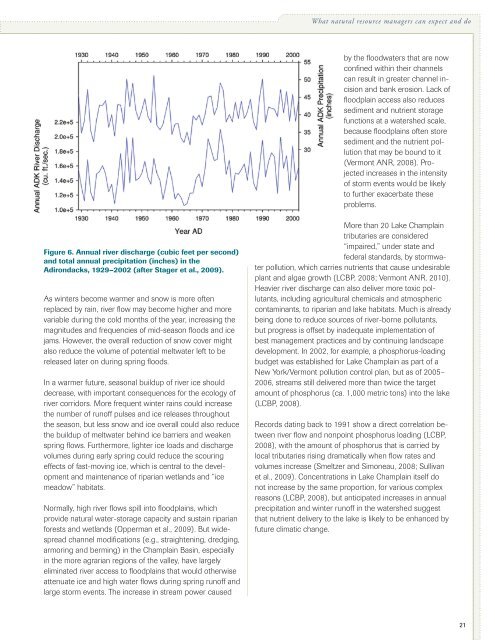Climate Change in the Champlain Basin - The Nature Conservancy
Climate Change in the Champlain Basin - The Nature Conservancy
Climate Change in the Champlain Basin - The Nature Conservancy
Create successful ePaper yourself
Turn your PDF publications into a flip-book with our unique Google optimized e-Paper software.
What natural resource managers can expect and doby <strong>the</strong> floodwaters that are nowconf<strong>in</strong>ed with<strong>in</strong> <strong>the</strong>ir channelscan result <strong>in</strong> greater channel <strong>in</strong>cisionand bank erosion. Lack offloodpla<strong>in</strong> access also reducessediment and nutrient storagefunctions at a watershed scale,because floodpla<strong>in</strong>s often storesediment and <strong>the</strong> nutrient pollutionthat may be bound to it(Vermont ANR, 2008). Projected<strong>in</strong>creases <strong>in</strong> <strong>the</strong> <strong>in</strong>tensityof storm events would be likelyto fur<strong>the</strong>r exacerbate <strong>the</strong>seproblems.Figure 6. Annual river discharge (cubic feet per second)and total annual precipitation (<strong>in</strong>ches) <strong>in</strong> <strong>the</strong>Adirondacks, 1929–2002 (after Stager et al., 2009).As w<strong>in</strong>ters become warmer and snow is more oftenreplaced by ra<strong>in</strong>, river flow may become higher and morevariable dur<strong>in</strong>g <strong>the</strong> cold months of <strong>the</strong> year, <strong>in</strong>creas<strong>in</strong>g <strong>the</strong>magnitudes and frequencies of mid-season floods and icejams. However, <strong>the</strong> overall reduction of snow cover mightalso reduce <strong>the</strong> volume of potential meltwater left to bereleased later on dur<strong>in</strong>g spr<strong>in</strong>g floods.In a warmer future, seasonal buildup of river ice shoulddecrease, with important consequences for <strong>the</strong> ecology ofriver corridors. More frequent w<strong>in</strong>ter ra<strong>in</strong>s could <strong>in</strong>crease<strong>the</strong> number of runoff pulses and ice releases throughout<strong>the</strong> season, but less snow and ice overall could also reduce<strong>the</strong> buildup of meltwater beh<strong>in</strong>d ice barriers and weakenspr<strong>in</strong>g flows. Fur<strong>the</strong>rmore, lighter ice loads and dischargevolumes dur<strong>in</strong>g early spr<strong>in</strong>g could reduce <strong>the</strong> scour<strong>in</strong>geffects of fast-mov<strong>in</strong>g ice, which is central to <strong>the</strong> developmentand ma<strong>in</strong>tenance of riparian wetlands and “icemeadow” habitats.Normally, high river flows spill <strong>in</strong>to floodpla<strong>in</strong>s, whichprovide natural water-storage capacity and susta<strong>in</strong> riparianforests and wetlands (Opperman et al., 2009). But widespreadchannel modifications (e.g., straighten<strong>in</strong>g, dredg<strong>in</strong>g,armor<strong>in</strong>g and berm<strong>in</strong>g) <strong>in</strong> <strong>the</strong> Champla<strong>in</strong> Bas<strong>in</strong>, especially<strong>in</strong> <strong>the</strong> more agrarian regions of <strong>the</strong> valley, have largelyelim<strong>in</strong>ated river access to floodpla<strong>in</strong>s that would o<strong>the</strong>rwiseattenuate ice and high water flows dur<strong>in</strong>g spr<strong>in</strong>g runoff andlarge storm events. <strong>The</strong> <strong>in</strong>crease <strong>in</strong> stream power causedMore than 20 Lake Champla<strong>in</strong>tributaries are considered“impaired,” under state andfederal standards, by stormwaterpollution, which carries nutrients that cause undesirableplant and algae growth (LCBP, 2008; Vermont ANR, 2010).Heavier river discharge can also deliver more toxic pollutants,<strong>in</strong>clud<strong>in</strong>g agricultural chemicals and atmosphericcontam<strong>in</strong>ants, to riparian and lake habitats. Much is alreadybe<strong>in</strong>g done to reduce sources of river-borne pollutants,but progress is offset by <strong>in</strong>adequate implementation ofbest management practices and by cont<strong>in</strong>u<strong>in</strong>g landscapedevelopment. In 2002, for example, a phosphorus-load<strong>in</strong>gbudget was established for Lake Champla<strong>in</strong> as part of aNew York/Vermont pollution control plan, but as of 2005–2006, streams still delivered more than twice <strong>the</strong> targetamount of phosphorus (ca. 1,000 metric tons) <strong>in</strong>to <strong>the</strong> lake(LCBP, 2008).Records dat<strong>in</strong>g back to 1991 show a direct correlation betweenriver flow and nonpo<strong>in</strong>t phosphorus load<strong>in</strong>g (LCBP,2008), with <strong>the</strong> amount of phosphorus that is carried bylocal tributaries ris<strong>in</strong>g dramatically when flow rates andvolumes <strong>in</strong>crease (Smeltzer and Simoneau, 2008; Sullivanet al., 2009). Concentrations <strong>in</strong> Lake Champla<strong>in</strong> itself donot <strong>in</strong>crease by <strong>the</strong> same proportion, for various complexreasons (LCBP, 2008), but anticipated <strong>in</strong>creases <strong>in</strong> annualprecipitation and w<strong>in</strong>ter runoff <strong>in</strong> <strong>the</strong> watershed suggestthat nutrient delivery to <strong>the</strong> lake is likely to be enhanced byfuture climatic change.21
















